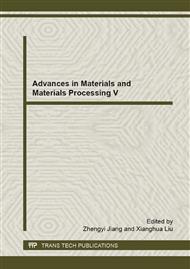[1]
Sim H K, Khaled O M, Kong Jackie Y J, et al. Cost of quality for an automotive industry: a survey and findings. International Journal of Manufacturing Technology and Management, 2009, 17(4): 437-452.
DOI: 10.1504/ijmtm.2009.023960
Google Scholar
[2]
Xu B S, DONG S Y, SHI P J. States and prospects of china characterised quality guarantee technology system for remanufactured parts. Journal of Mechanical Engineering, 2013, 49(20): 84-90(in Chinese).
DOI: 10.3901/jme.2013.20.084
Google Scholar
[3]
Chin K S, Duan G, Tang X. A computer-integrated framework for global quality chain management. The International Journal of Advanced Manufacturing Technology, 2006, 27(2): 547-560.
DOI: 10.1007/s00170-004-2202-8
Google Scholar
[4]
Pham D T, Waini M A. Feature-based control chart pattern recognition. International Journal of Production Research, 1997, 35(7): 1875-1890.
DOI: 10.1080/002075497194967
Google Scholar
[5]
Liu D Y, Jiang P Y, Zhang Y F. An e-quality control model for multistage machining processes of workpieces. Science in China Series E: Technological Sciences, 2008, 51(12): 2178-2194.
DOI: 10.1007/s11431-008-0240-4
Google Scholar
[6]
Ni M, Xu X F, Deng S C. Extended QFD and data-mining-based methods for supplier selection in mass customization. International Journal of Computer Integrated Manufacturing, 2007, 20(2-3): 280-291.
DOI: 10.1080/09511920601150651
Google Scholar
[7]
Chen Y, Jin J H. Quality-reliability chain modeling for system-reliability analysis of complex manufacturing process. IEEE Transactions on Reliability, 2005, 54( 3): 475-488.
DOI: 10.1109/tr.2005.853441
Google Scholar
[8]
ZHANG G X. Quality management. Bei jing: Higher Education Press, 1998(in Chinese).
Google Scholar
[9]
Bai B G, Sun Z. Quality cost decision-making theory. Beijing: Social Sciences Academic Press, 2012(in Chinese).
Google Scholar
[10]
Guh R S. Integrating artificial intelligence into on-line statistical process control. Quality and Reliability Engineering International, 2003, l9(1): 1-20.
DOI: 10.1002/qre.510
Google Scholar
[11]
Yang J H, Yang M S. A control chart pattern recognition system using a statistical correlation coefficient method. Computers & Industrial Engineering, 2005, 48(2): 205-221.
DOI: 10.1016/j.cie.2005.01.008
Google Scholar
[12]
Wang P, Zhang D H, Li S, et al. Machining error control by integrating multivariate statistical process control and stream of variations methodology. Chinese Journal of Aeronautics, 2012, 25(6): 937-947.
DOI: 10.1016/s1000-9361(11)60465-2
Google Scholar
[13]
Premachandra I M, Bhabra G S, Sueyoshi T. DEA as a tool for bankruptcy assessment: a comparative study with logistic regression technique. European Journal of Operational Research, 2009, 193(2): 412-424.
DOI: 10.1016/j.ejor.2007.11.036
Google Scholar
[14]
Ali A I, Lerme C S, Seiford L M. Components of efficiency evaluation in data envelopment analysis. European Journal of Operational Research, 1995, 80(3): 462-473.
DOI: 10.1016/0377-2217(94)00131-u
Google Scholar
[15]
Quan L W, Hong Y, Lu J S. The necessary and sufficient conditions for returns to scale properties in generalized data envelopment analysis model. Science in China Series E: Technological Sciences, 2011, 54(4): 831-844.
Google Scholar


